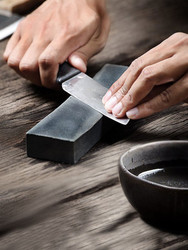The Value of a Sharp Knife
27th Feb 2017
A sharp knife is a good knife. If you fail to maintain an edge, the knife becomes nothing more than a hammer or a club. A sharp knife is also a safer knife, which we will discuss later. There are several ways to keep your knives sharp – whetstone or a steel, handheld or electric sharpener.
We often hear the term “honing” with regards to knife maintenance. It is important to recognize the difference between honing and sharpening. Honing essentially pushes the edge of the knife back to the center. Honing a knife keeps the blade in proper shape and the edge will last longer between sharpening.
Sharpening is different in that bits of the blade are taken off to bring about a new edge. Thus, it is not necessary or advisable to sharpen the knife more than twice a year, depending on the usage. An over-sharpened knife will lose the original blade shape.
It is always advisable to use the sharpener of the same brand as your knife, as steel hardness changes with different manufacturers.
Why is sharpening a knife important?
A sharp knife is a safe knife. It cuts and slices easily and does what it is intended to do. A blunt blade would mean extra effort to do the same thing and that increases the likelihood of the knife slipping and cutting a finger or some other part of the hand. Also, a sharp knife is a far efficient tool that saves time and mental effort.
Some safety tips
- Cut away from the body.
- Do not toss knives.
- Do not attempt to catch a falling knife.
- Do not run with a knife in your hand.
- Do not walk with the point facing another person (or yourself).
- Keep knives away from children.
- Maintain the knife. Sharp knives are safer as we’ve already covered.
- Do not use the tip to open a container; the tip could break.
- Don’t run your fingers across the blade to test the sharpness. Remember, blade cuts flesh.
- Use knives on a firm surface, such as a wooden or polyethylene board.
- Use knives in their proper capacity. For instance, do not use a kitchen knife on frozen food; let the food thaw first.


 Gift Cards
Gift Cards